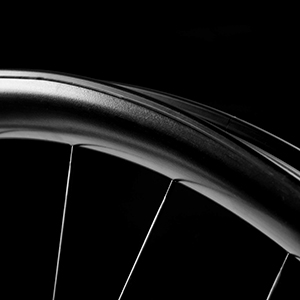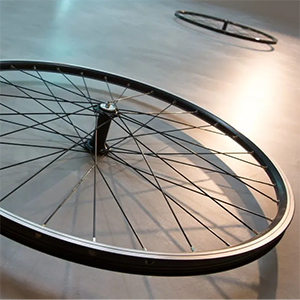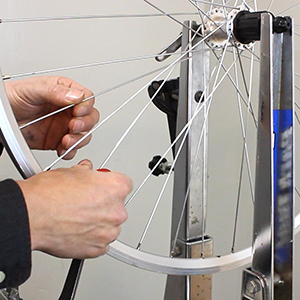
Carbon Rims vs Aluminum Rims: The 2025 Ultimate Comparison Guide
Have you ever wondered why professional cyclists often choose carbon rims while recreational riders tend to stick with aluminum rims? In the world of modern cycling, the choice between carbon rims vs aluminum rims can significantly impact performance, comfort, and cost. Aluminum wheels provide reliable performance at an affordable price, making them ideal for everyday riding and budget-conscious cyclists. On the other hand, carbon fiber rims offer reduced weight, improved aerodynamics, and superior responsiveness, delivering a performance edge for competitive riders, albeit at a higher cost. Ultimately, the best choice depends on your riding style, cycling goals, and personal preferences.

In this section, we start with the most intuitive "weight and aerodynamics" to explain why the weight and shape of the rims are crucial to riding efficiency and handling. Whether it is climbing efficiency when climbing a hill or wind resistance performance when sprinting on a flat road, weight and aerodynamics are key factors.
When you lift a typical 30 mm-deep aluminum rim, you’re handling about 620 grams of solid alloy. Swap it for a carbon counterpart, and you’ll shave that down to roughly 420 grams. Why? Aluminum alloy clocks in at around 2.7 g/cm³, whereas carbon fiber composites average just 1.6 g/cm³.
Carbon fiber rims allow designers to mold complex, sophisticated shapes that blend deep sections with smooth curvature, something aluminum stamping can't match, optimizing airflow around the wheel. Unlike aluminum rims, which require surface finishing after extrusion, carbon fiber can be molded into the desired aerodynamic profile in a single step. Picture a rim with a deep U-section at the trailing edge, tapering into a narrower lip up front; this curvature "smears" airflow smoothly around the wheel, showcasing carbon's unique advantages: it isn't just light, but highly moldable for superior aerodynamic performance.
Numbers can be startling. With a complete carbon wheelset, you might save 400 grams compared to an aluminum wheelset, equivalent to lugging around an extra half-liter water bottle.
Lightweight rims respond faster. When you sprint out of a corner, carbon hoops come up to speed in a fraction of a second that aluminum can’t match.
Carbon vs Aluminum Rim Comparison Table
|
Feature / Metric |
Carbon Rims |
Aluminum Rims |
|
Weight (30 mm rim) |
~420 g |
~620 g |
|
Material Density |
1.6 g/cm³ |
2.7 g/cm³ |
|
Acceleration |
Faster |
Slower |
|
Climbing Efficiency |
Higher |
Moderate |
|
Aerodynamic Shaping |
Highly moldable, optimized airflow |
Limited by extrusion and stamping |
|
Rotational Inertia |
Lower |
Higher |
When it comes to carbon rims vs aluminum rims, stiffness and ride feel are critical factors that determine how efficiently your pedaling power translates into forward motion. Every watt you generate goes somewhere; stiffer wheels transfer more energy directly to propulsion, while more flexible rims absorb part of that energy as unwanted flex.
How Stiffness Affects Power Transfer
Stiffness measures a wheel’s resistance to lateral flex when climbing out of the saddle or sprinting over rough terrain. A stiffer rim allows more of your effort to propel the bike forward rather than being lost as deformation.
Carbon rims typically have lateral stiffness ratings around 70–90 Nm/°, while comparable aluminum rims register 45–60 Nm/°. This means carbon rims can be up to 50% stiffer, providing faster acceleration and more efficient power transfer during sprints and climbs.
Ride Response: Lively Carbon vs Supple Aluminum
Carbon rims deliver a “lively” ride—snappy, precise, and optimized for explosive efforts. Their high stiffness provides instant feedback, making them ideal for racers and aggressive riders who want to feel every watt applied.
Aluminum rims, in contrast, offer a more forgiving, “supple” feel. Their relative compliance absorbs vibrations from rough roads, improving comfort during long rides and reducing rider fatigue. For endurance cyclists, this can help maintain steadier power output over extended periods.
Perceived Ride Feel
Carbon Rims: Razor-sharp response, precise cornering, and immediate power translation. Preferred by riders chasing performance and milliseconds.
Aluminum Rims: Gentle flex under load, vibration absorption, and a cushioned ride. Ideal for comfort, long rides, and rough terrain stability.
Stiffness & Ride Feel Comparison Table
Feature / Metric
Carbon Rims
Aluminum Rims
Lateral Stiffness
70–90 Nm/°
45–60 Nm/°
Power Transfer Efficiency
High
Moderate
Ride Response
Lively, snappy, precise
Supple, forgiving, comfortable
Cornering Precision
Sharp
Moderate
Vibration Absorption
Low
High
Ideal Rider Type
Competitive / Aggressive
Endurance / Comfort-focused
While the durability of a wheel affects your riding confidence and long-term value, its appearance affects how you feel on every ride. Let’s explore the fatigue life range of carbon fiber and aluminum wheels and compare the appeal of each material’s appearance to different riders.
When you invest in a wheelset, you want confidence that it’ll last. Carbon rims typically boast a fatigue life of around 5,000–8,000 kilometers under mixed riding conditions. High-quality carbon layups resist micro-cracking, but repeated impacts or improper storage can accelerate wear. In contrast, aluminum rims often endure 10,000–20,000 kilometers before fatigue becomes a concern, nearly double carbon’s lifespan.
A 2024 wheel lab study found that 85% of aluminum rims maintained structural integrity after 15,000 km, whereas only 60% of carbon rims did the same under identical stress tests.

Aluminum rims, on the other hand, have a more understated and classic appearance. They typically come with a machined brake track and visible weld joints, which might not appeal to riders chasing a sleek, futuristic look. However, their simplicity can be attractive in its own right—especially for those who prefer a minimalist or retro style.
Carbon rims also offer more customization when it comes to finishes and graphics. From subtle weaves to striking decals, the possibilities are nearly endless. This flexibility allows you to match your wheels to your frame and personal branding.
When comparing carbon rims vs aluminum rims, price is often a key consideration. Carbon fiber rims are lightweight and strong, but their production is complex and costly. Each rim requires custom molds, hand-laid pre-impregnated carbon sheets, and precise autoclave or oven curing, processes that demand skilled labor and clean, controlled facilities. The tooling costs for specialized rim profiles are high, and lower production volumes mean these investments are spread across fewer units.
Strict quality control further drives costs. Carbon rims undergo ultrasonic or X-ray inspections, fatigue and impact testing, and rigorous prototyping for aerodynamic shapes and optimized fiber layouts. These steps reduce defects but increase production overhead and development expenses.
Additionally, careful packaging, specialized handling, certifications, warranty support, and premium brand positioning all contribute to the final price. Together, these factors explain why carbon rims are significantly more expensive than aluminum rims, reflecting both advanced engineering and high-performance benefits.
Taking care of your wheels isn’t just about keeping them clean—it’s about preserving performance, safety, and longevity. Whether you ride on carbon or aluminum rims, proper maintenance makes a noticeable difference.
For carbon rims, always inspect the braking surface or disc interface after long descents or wet rides. Heat buildup from rim brakes can degrade carbon over time, so use carbon-specific brake pads and avoid prolonged heavy braking. Clean the rims gently with a soft cloth and mild soap—harsh chemicals can damage the resin finish. Look for signs of delamination or cracks, especially around the spoke holes and braking track.
Aluminum rims are a bit more forgiving but still need attention. If you're using rim brakes, check for wear grooves or uneven surfaces that can affect braking power. Aluminum can oxidize, so wiping down after wet or salty rides (like in coastal areas) helps prevent corrosion. Use a fine brush or cloth to remove grit lodged near the brake track or spoke nipples.
Both types of rims benefit from regular truing and tension checks. A wobbly wheel is more than annoying—it can damage spokes or the rim itself. Treat your wheels well, and they’ll reward you with smoother, safer rides for years to come.

Choosing between carbon rims and aluminum rims comes down to your priorities as a rider—performance vs. value, speed vs. durability, aesthetics vs. practicality.
If you’re chasing every watt, climbing mountains, or racing against the clock, carbon rims are hard to beat. They’re lighter, more aerodynamic, and stiffer, which means better power transfer and quicker acceleration. You’ll feel the difference on long climbs and fast descents. Plus, their sleek look adds serious style points to any bike.
But carbon comes at a cost—not just financially, but also in terms of fragility. A hard impact or crash could crack a carbon rim, and repairs can be tricky or even impossible.
On the other hand, aluminum rims are reliable workhorses. They’re tougher when it comes to impact resistance, more affordable to replace, and perform consistently across all conditions. If you’re commuting, riding gravel, or just getting into the sport, aluminum might be the smarter choice.
Are carbon rims worth the extra investment?
If you're a performance-oriented rider or a racer, carbon rims can absolutely be worth the cost. They’re lighter, stiffer, and more aerodynamic, which can translate to faster climbs and smoother handling. For example, a set of carbon wheels can shave up to 300 grams compared to aluminum—enough to make a real difference on long rides or in competition. But if you're riding casually or on a budget, aluminum still offers excellent value.
Can I safely use rim brakes on carbon wheels?
Yes, but you need to use carbon-specific brake pads and follow the manufacturer’s guidelines. Carbon heats up faster than aluminum, especially on long descents. Overheating can cause damage or even lead to failure, so it's important to brake in intervals and avoid dragging the brakes.
How often should I replace my rims?
That depends on your riding habits. For heavy riders or those tackling rough terrain, inspect your rims every few thousand kilometers. Aluminum rims often show wear on the brake track, while carbon may require closer inspection for cracks or delamination.
What maintenance does each material require?
Carbon needs gentle cleaning, brake track care, and regular inspections. Aluminum is more forgiving but still benefits from cleaning, brake surface checks, and truing. Both need love to last.
By now, you have a clear picture of carbon rims vs aluminum rims: carbon leads on weight and aero tuning, while aluminum wins on cost, repairability, and heat management. Your ideal choice depends on your riding style, budget, and maintenance preferences. Ready to elevate your ride? Browse our curated selection of carbon and aluminum rims today and pedal into performance!
Categorías
Nuevo blog
Derechos de autor © 2025 Top-Fire Carbon Technology Co., Ltd. Reservados todos los derechos. Poder por

Red IPv6 admitida